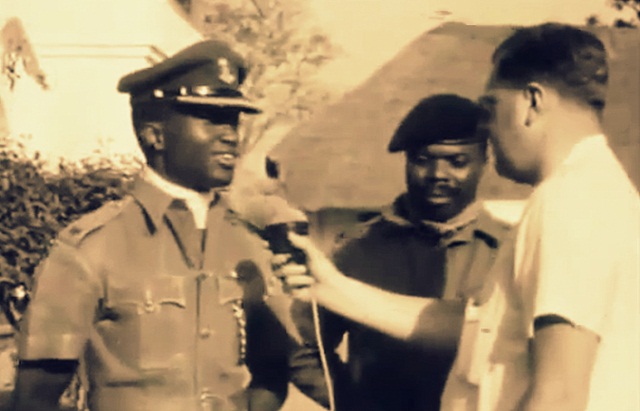BY ODION OMONFOMAN
It is important to state upfront that I don’t know much about MRS Alakija and have never met her in person. But I am familiar with her story, how she came about OPL 216 as well as the actual status of OPL 216 as at the time of award. There are a lot of verifiable facts as there are myths surrounding how she came about being awarded the very prolific oil block. The objective of this article is simply to lay down some of these facts to aid the discussion.
Indigenization Policy & Local Content 1.0
To understand how Mrs. Alakija and Famfa Oil came about being awarded one of Nigeria’s most prolific oil blocks, one must first understand the Indigenization policy in the upstream oil and gas sector which the IBB regime pioneered, and which led to the discretionary award process of oil blocks.
Advertisement
In 1990/1991, the IBB regime recognized that the upstream oil and gas sector was solely dominated by International Oil Companies (IOC). Other than Dubri Oil Company Limited which was founded in 1987, there was no indigenous, Nigerian owned or controlled E&P company in the upstream oil and gas sector. To encourage Nigerian participation in the exploration, development and production of Nigeria’s oil and gas reserves, Professor Jubril Aminu, who was then the Minister for Petroleum instituted a process for bringing in Nigerian entrepreneurs whom the government felt either had the financial muscle and/or could mobilize both financiaOgl and technical resources to carry out E&P activities. The indigenization policy of the IBB regime is the first attempt at developing a local content policy in developing and managing our oil and gas reserves.
The first set of discretionary awards to Nigerians was done in 1991 and some recipients of oil blocks were very notable Nigerians who owned banks, financial institutions and large conglomerates then. It is instructive to state that the blocks were not offered for free as is speculated. Each awardee had to pay a signature bonus of at least US$1.5million for the license. It must however be said that the government deliberately lowered the conditions of award to ensure that Nigerian companies were able to meet the terms of the licenses.
In 1993, the IBB regime awarded further licenses to more Nigerian companies on same discretionary terms. Mrs. Alakija’s company benefited from the second award.
Advertisement
OPL 216 – A block no one wanted
As unbelievable as it may sound today, OPL 216 was an oil block no one wanted. Not even the IOCs. Why? The OPL 216 acreage is located in the deep offshore area in the Gulf of Guinea in water depths of over 1, 300m (1.3km). At the time of award, the block had no known proven reserves and was considered uneconomically viable by IOCs. In addition, even if there were proven commercial reserves, because of its location and water depth, it would require significant capital and expensive but not proven deep-water technology to explore and develop. Deepwater offshore technology was still at its infancy then. There were no Floating Production Storage and offloading (FPSO) terminals available then. Thus several IOCs rejected the block when the Nigerian government offered it to them for almost nothing.
Enter Famfa Oil
Famfa Oil, owned by Mr. and Mrs. Alakija, applied for and was awarded OPL 216 in 1993. Mrs. Alakija, a fashion designer of repute and an entrepreneur, is alleged to have used her access to the then first Family to seek for the oil block at the twilight of the IBB regime. Many say it was compensation for her loyalty and work to the first family.
Advertisement
Two things strike me about this story which disputes this allegation and lends credence to Mrs. Alakija’s entrepreneurial status, tenacity and focus as the main reason she got the block. First is the fact that Famfa Oil was incorporated in 1991, obviously when the first round of awards was issued and granted. This shouldn’t be strange as all Nigerian companies awarded OPL licenses to were also incorporated then. Her company Famfa, clearly wasn’t favoured in that first round, despite her supposed closeness to the then first lady.
Second is that Mrs. Alakija must have had a very clear vision of her future and didn’t “stumble luckily” into big oil. Despite a price tag of US$1.5million, she still persisted and went ahead to apply for an oil prospecting license for a second time two years after her first attempt. Mrs. Alakija certainly did not set out to acquire OPL 216. She was only “unfortunate” to be awarded the block no one wanted.
Now was Mrs. Alakija and Famfa Oil undeservedly awarded the OPL by the IBB regime? The answer is clearly “No” as the award of the OPL to Mrs. Alakija and her company followed the rule of law and the guidelines for discretionary awards. Mrs. Alakija must have met all requirements leading to the award, or eventually perfected them with time as many in her shoes did then. In addition, the award of the OPL to Mrs. Alakija had no conflict of interest as is the case with OPL 245 (Malabu Oil).
One must recognize that the Head of State had the powers to make such discretionary awards. Thus it is illogical to claim that Mrs. Alakija and Famfa obtained the block fraudulently or she was acting as a front to the former military ruler and his family. In addition, OPL 216 was awarded on a Sole Risk basis, meaning that Famfa and her promoters were solely responsible for developing the block without the participation of the Nigerian government. Many Sole risk operators have gone bankrupt just simply trying to explore their blocks.
Advertisement
Agbami Field and OML 127
Mrs. Alakija recognizes her good fortune and is very effervescent about how faith eventually played her destiny concerning OPL 216.
Advertisement
After being awarded the OPL, Famfa had tried unsuccessfully to enter into development agreements with several IOCs that had the technology and resources for deep-water offshore exploration. Things also didn’t favour Famfa and other awardees politically during this period. Recall these were the dark days following the June 12 annulment, the regime of Sani Abacha, killing of the Ogoni Five and arising international sanctions. Thus it was difficult for Famfa and other Sole Risk operators to secure technical and financial partnerships.
In 1996, Famfa Oil entered into a Deed of Agreement (DoA) with Star Deepwater (Texaco) which Star Deepwater was assigned 40% participating interests in OPL 216. Someone familiar with the story claims Star Deepwater entered into the DoA extremely reluctant, considering the uneconomic status of the block. However, the rest they say is history. In 1998, Agbami field was discovered, with estimated P50 recoverable reserves of over one billion barrels of oil. The Agbami field discovery was the second major deep-water discovery in the Gulf of Guinea after the Bonga field discovery by Shell and ushered Nigeria into the age of deep-water oil and gas production.
Advertisement
In 1998, Petrobras of Brazil acquired 8% of Texaco’s 40% interests. Despite the crash in oil prices in 1998 – 2000 as a result of the Asian financial crisis, the co-venturers continued their appraisal of the Agbami field. In 2003, OPL 216 became OML 127. In 2008, OML 127 achieved first oil and started commercial production. Again faith came in handy as this was a time of high oil prices, favoring deep-water offshore developments.
Anybody familiar with deep-water oil and gas operations would tell you that it is one of the toughest environments to prospect for, develop and produce oil and gas. Thus one must commend the tenacity of Mr. and Mrs. Alajika and the management of Famfa Oil for braving all odds to bring OPL 216 into production fifteen years after being awarded the block.
Advertisement
Today, Agbami produces over 200,000 barrels of crude oil and gas liquids, contributing to Nigeria’s total hydrocarbon production and our total national oil and gas reserves. Agbami has also added immensely to developing local content in the Nigeria oil and gas sector, particularly in deep-water operations. I hope Famfa Oil would tell its story and contributions to the Nigerian economy much better than I can tell it.
By the way, it is pertinent to ask how many other Nigerian entrepreneurs who were awarded shallow and deep-water leases since 1991 have been able to reach commercial production of crude oil or gas?
Applause for Mrs Alakija and Famfa Oil
In my view, Mrs. Alakija deserves commendation and all the accolades for her role in growing her company.
First, Mrs Alakija deserves commendation for undoubtedly being an exceptional fashion designer. We all remember how fashionable Mrs. Maryam Babangida of blessed memory was. She was Nigeria’s version of Lady Diana. No doubt, Mrs. Folorunsho Alakija must have been very good at her tailoring craft! One must remember that Mrs. Alakija rose from very humble beginnings to hone her craft such that it caught the attention of the then first Lady.
Not being one to be limited by her ambition, she sought to play in the upstream oil and gas space. Only the brave-hearted, and most certainly not a woman at the time, could have had that desire. And as usual, Mrs. Alakija has also excelled here, well beyond every expectation. Today she is an inspiration to countless successful women who now play in the upstream oil and gas sector.
Mrs. Alakija and her company have also weathered numerous storms unleashed by the government. In 2000 the Obasanjo Government through the Nigerian National Petroleum Corporation sought to compulsorily acquire 40% of Famfa’s interest in OPL 216. In 2005, the Obasanjo government again sought to acquire a 50% participating interest in Famfa’s equity in OML 127 under government’s back- in rights. The back-in rights give the Federal Government a right to participate in deep-water OMLs by acquiring five-sixths of the allottee’s interest in the relevant OPL and/or OML. To preserve its rights and interest in OML 127, Famfa took the Federal Government to Court. The arising court judgements, all the way to the Supreme Court are landmark judgements which have helped promote the rule of law in the Nigerian oil and gas industry.
Drawbacks for Famfa
Famfa’s mission on its website is “to be the leading indigenous Nigerian oil and gas exploration and production company”. With only just its working interest in OML 127, Famfa may be far from achieving its mission statement. In addition, with her tremendous wealth, Mrs. Alakija and Famfa need to conquer new grounds in the oil and gas industry, particularly the midstream and downstream sectors, which are crying for investments. Famfa needs to add value to its share of crude oil and gas production from OML 127 by strategic investments in midstream and downstream infrastructure within Nigeria. Perhaps, that may already be in the works for Mr. & Mrs. Alakija.
Conclusion
The Twitter post of Kayode Ogundamis, celebrated Nigerian journalist, is hinged on individuals like Mrs. Alakija using their access to the corridors of power to grab national resources and shortchange Nigerians. While this may ring true when one considers how the discretionary award process was abused under the Abacha and Obasanjo governments and also the privatization of several national assets, it is most unfair to use Mrs. Alakija as the “poster girl” for his post.
Firstly, Mrs. Alakija and Famfa have demonstrated she was actually the right entrepreneur that was sought by the Nigerian government under the indigenization and discretionary award policy. It is to her credit that Famfa, a Nigerian company controls majority interests in OML 127. This fact should not be rubbished or ignored.
Secondly, the process of award of OPL 216 to Mrs. Alakija is no different from the award of OPLs to IOCs by past regimes of the 1960s and 1970s which were also largely discretionary. Mr. Ogundamisi misses the fact that the Nigerian government did try to acquire 50% of OML 127 under the Back-In rights regulations. The Supreme Court in a landmark judgement in 2012 nullified the action of the Federal Government.
By the way, Nigeria is made up of oil blocks from the deep offshore in the Gulf of Guinea to the shallow waters and swamps in the Niger Delta, all the way to the semi-arid and arid landscapes in the Lake Chad Basin and Sokoto Basin. Oil blocks by their nature are only productive to a country if and only if they hold hydrocarbon reserves which can be exploited commercially for the benefit of the country. To get to this point carries significant technical and financial risks to the operator, including the risk of not finding commercial quantities of hydrocarbons. I wonder if Mr. Ogundamisi would have made his claim against Mrs. Alakija, if Famfa and her partners had not met with success in discovering commercial quantities of crude oil in OPL 216?
There are numerous oil blocks and marginal fields awarded by past governments to Nigerian companies, whose Nigerian owners have either failed to explore and develop them or simply lack the resources as well as the technical and managerial savvy to attract resources to develop these fields. The marginal fields program comes to mind.
This should be Mr. Ogundamisi’s concern – how to get the Nigerian owners to develop these blocks/marginal fields or relinquish these blocks/marginal fields back to the Nigerian Government or other indigenous parties capable of exploring, developing and monetizing the hydrocarbon resources for the benefit of Nigeria and Nigerians.
Omonfoman, an energy consultant, is the managing director of New Hampshire Capital Ltd. He can be reached [email protected]
Views expressed by contributors are strictly personal and not of TheCable.
Add a comment






